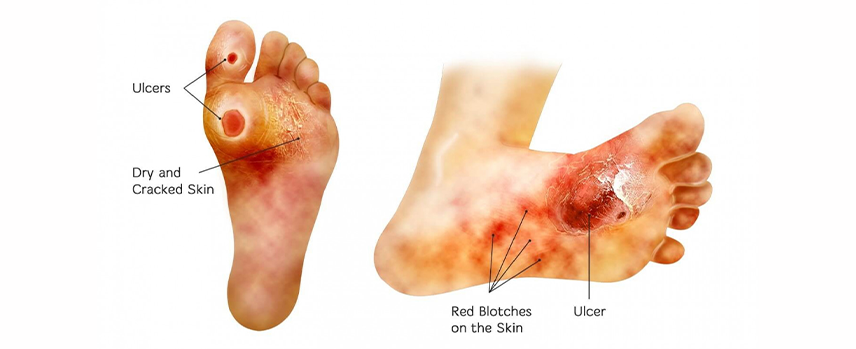
Diabetic foot is a serious condition that arises due to prolonged high blood sugar levels, leading to nerve damage (neuropathy) and poor blood circulation in the feet. This condition can result in foot ulcers, infections, and, in severe cases, the need for amputation. Individuals with diabetes should pay close attention to foot health to avoid complications.
If you experience persistent foot pain, swelling, redness, or slow-healing wounds, seeking immediate medical care is essential. Visiting a trusted diabetic foot clinic in Kolathur or consulting an experienced diabetic foot specialist in Mogappair ensures proper evaluation and timely treatment. Timely intervention can help prevent complications and support quicker recovery.
Proper foot care and regular check-ups play a crucial role in managing diabetic foot conditions. Patients are advised to maintain good foot hygiene, wear comfortable footwear, and inspect their feet daily for cuts, blisters, or signs of infection. Additionally, controlling blood sugar levels is essential to improve circulation and reduce the risk of complications. At our dedicated diabetic foot clinic in Kolathur and diabetic foot care center in Mogappair, we provide comprehensive care plans tailored to each patient's needs, ensuring effective treatment, faster recovery, and long-term foot health.
Recognizing the early warning signs of diabetic foot is crucial in preventing severe complications and ensuring timely medical intervention. Common symptoms include persistent pain, swelling, redness, or warmth in the affected foot. You may also notice slow-healing wounds, ulcers, or blisters that seem resistant to traditional remedies. Other warning signs include numbness, tingling sensations, or a loss of feeling in the feet, which can result from nerve damage (neuropathy). Additionally, changes in skin color, foul-smelling discharge, or blackened tissue are indicators of poor blood circulation and possible infection, requiring immediate attention.

If you experience any of these warning signs, it’s vital to visit a diabetic foot care center in Kolathur or consult a skilled diabetic foot doctor in Mogappair for proper diagnosis and treatment. Early detection plays a significant role in improving recovery outcomes, preventing severe damage, and reducing the risk of amputation. By seeking timely care from experienced specialists, you can manage your condition effectively and maintain better foot health.
Surgical intervention is often required for diabetic foot conditions that have progressed to a severe stage, especially when infection, extensive tissue damage, or inadequate response to non-surgical treatments are present. In cases where the affected area shows signs of gangrene, abscess formation, or spreading infection, surgery becomes crucial to prevent further complications, including the risk of amputation. Surgical procedures may involve debridement (removal of dead or infected tissue), drainage of abscesses, or reconstructive surgery to improve blood flow and promote healing.
Our experienced diabetic foot surgeons in Kolathur and skilled diabetic foot specialists in Mogappair thoroughly assess each patient's condition to determine the most appropriate surgical approach. Factors such as the severity of the infection, extent of tissue damage, and overall health condition are carefully considered to ensure the best possible outcome.
Following surgery, comprehensive post-surgical care is provided to support recovery and minimize complications. This includes meticulous wound care to promote faster healing, effective pain management strategies to enhance comfort, and personalized guidance on foot care practices to prevent future issues. Regular follow-up visits are scheduled to monitor the healing process, assess circulation, and ensure that the surgical site remains infection-free. By combining advanced surgical techniques with attentive post-operative care, we aim to help patients regain foot health and improve their overall well-being.


Accurate diagnosis is essential for creating a tailored and effective diabetic foot treatment plan. At our specialized diabetic foot clinic in Kolathur and diabetic foot hospital in Mogappair, we utilize advanced diagnostic methods to assess the severity, underlying causes, and extent of the condition. Our diagnostic approach includes tools like Doppler ultrasound to evaluate blood flow, nerve conduction studies to assess nerve damage, and wound culture tests to identify infections.
These advanced techniques enable our specialists to pinpoint issues such as poor circulation, neuropathy, or hidden infections that may not be immediately visible. By obtaining a precise diagnosis, we can develop a personalized treatment strategy that targets the root cause, prevents complications, and promotes faster healing. Our dedicated team ensures that each patient receives comprehensive care for improved foot health and overall well-being.
- Doppler ultrasound to assess blood flow
- X-rays to identify bone damage or infection
- Wound culture tests to detect bacterial infections
- Wound culture tests to detect bacterial infections

Our experienced team ensures personalized care with tailored treatment plans that address each patient's condition. With a combination of advanced medical techniques and compassionate care, we aim to improve foot health, enhance mobility, and prevent future complications.